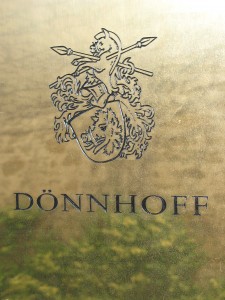Helmut & Cornelius Dönnhoff visit Berrys to present their 2010 vintage
Author: David Berry Green
 It was a priceless moment during the Dönnhoffs’ visit to Berrys, Basingstoke, on Wednesday last when legendary Riesling producer and father Helmut Dönnhoff recounted how he grew his family’s plot of Niederhauser Hermannshöhle, Nahe’s finest site, from just three rows (0.01 hectares) in 1971 to over four hectares today; 50% of the total vineyard. In fact so highly rated is the Hermannshöhle terroir that apparently locals use the name to benchmark the quality of wines in the area.
It was a priceless moment during the Dönnhoffs’ visit to Berrys, Basingstoke, on Wednesday last when legendary Riesling producer and father Helmut Dönnhoff recounted how he grew his family’s plot of Niederhauser Hermannshöhle, Nahe’s finest site, from just three rows (0.01 hectares) in 1971 to over four hectares today; 50% of the total vineyard. In fact so highly rated is the Hermannshöhle terroir that apparently locals use the name to benchmark the quality of wines in the area.
Helmut had from the start of his career viewed the Dönnhoff estate as one that should have at its heart the mighty Hermannshöhle vineyard. Sensing that a prominent local family might entertain an offer for some of their Hermannshöhle vines he embarked on a mission of familiarisation, even taking up dance classes frequented by one of the daughters! Eight years of such reconnaissance (and fancy footwork) brought him to a point at which he felt he could reasonably approach the head of the family with a request to buy 1.5 hecatres. Told to ‘come back tomorrow’ Helmut dutifully did and so was rewarded for his travails!
The second slice was ingeniously earned through Helmut’s harvesting of intelligence as to which of his Nahe vineyard neighbours also owned Hermannshöhle vines. He reckoned that one grower in particular was probably more attached to Kupfergrube, of which Helmut owned a nice parcel, than he was to Hermannshöhle. A reciprocal swap was therefore arranged that suited both sides.
And only in the last couple of years did the Dönnhoffs complete on the final piece of their prized Hermannshöhle holding when they acquired it from the German State itself!
Such a lovely story further re-enforced for me the humanity and authenticity of this family whose roots extend deep into the village of Oberhausen and its vineyards. Now famous ‘thanks’ to an American wine journal, the Dönnhoffs remain totally focused on producing great wines that reflect and respect their provenance and vintage. In fact one of my colleagues, on meeting the Dönnhoffs for the first time, was stunned at how humble and normal they appeared, in spite of all the press hyperbole. And in the background Cornelius Dönnhoff appeared very much his father’s son, both in geniality and sincerity.
On presenting twelve Dönnhoff wines from the 2010 vintage, still on their lees, Helmut suggested that this was a vintage when great sites shone. Which is why, he explained, that on the basis he applies the same work to all his vines he much prefers great vineyards to less great ones! It was a vintage in which higher, better exposed sites performed better than those lower down. The flowering was disrupted to give small berries and a smaller quantity (down 25%). A cool summer meant high acidities while the long, dry, windy autumn concentrated the juice and crucially delivered dry extracts that exceeded by up to 6 grams/litre those of 2009. As Helmut reminded us, great Riesling needs light and long hang time to reach perfection (…just like Nebbiolo in fact!!)
Tasting the wines one was struck by their beautiful balance, reminiscent of 1990 according to Helmut. The taut acidity matched perfectly by ripe fruit and textured salty minerality. As Cornelius mentioned, this was a year in which, from the off in the winery the vineyard character could be clearly defined. All were highlights but in particular I marvelled at the Felsenberg Felsenturmchen Riesling Dry Grosses Gewäächs, a phenomenally fine-tuned thing, at the dry equivalent of Auslese, with its calcareous floral finesse. Then there was the pretty Kreuznacher Krötenpfuhl Riesling Kabinett, so delicate and detailed…and of course both Oberhauser Brücke and Niederhauser Hermannshöhle, each one so different from the other, each one a carbon copy of their terroir (whatever the vintage); one beloved of Helmut’s mother (Brücke), the other by his father (Hermannshöhle)!
Brücke has a higher loam content, less slate and a lower aspect, giving snow-like essence; so soft, pulpy and sublime as a Spätlese, yet with scintillating acidity that makes it dance on your palate! The Auslese version was harvest at the end of November, along with approx. 30% botrytis fruit; a model of pinpoint refinement. The Eiswein, harvested on Christmas Day, has a rush of mountain-stream like purity. Hermannshöhle is muscular by comparison, thanks perhaps to its 100% rocky grey slate soil, older vines and drier, higher aspect. Smoky, meaty, linear and formidable; not for faint hearted. In a word ‘aristocratic’.
And as to when to drink his wines, Helmut suggested that the new vintage was delicious to drink over its first year, preppy fresh, but then after that best left for five or six years before trying again. Eiswein, in his words, best drunk young up to ten years old, while one waits for the Beernesuslese and Trockenbeerenausleses! So time to register your interest in the limited quantities of Dönnhoff 2010 about to be released…!



great wines – had the pleasure of visiting the estate a couple of years back – thanks for your superb report
Thank you Doctor. I do my best.